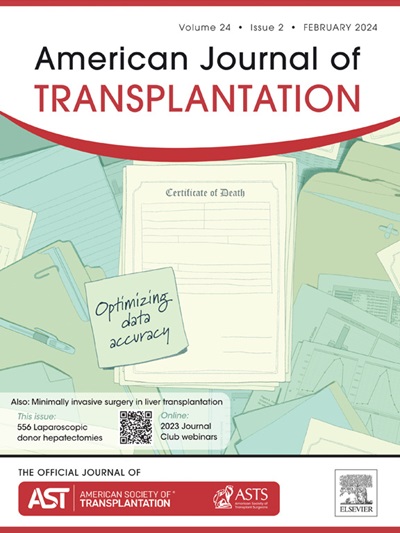确定肾移植手术中目标导向麻醉的目标:对高强度手术时间序列的队列分析。
IF 8.9
2区 医学
Q1 SURGERY
引用次数: 0
摘要
移植肾功能延迟(DGF)会增加肾移植受者的发病率和死亡率。手术参数,包括通过血管加压和输液进行的血流动力学操作,会影响新移植肾的灌注,并影响 DGF 的发生率。我们分析了肾移植受者手术(545 人)中每 5 分钟一次的术中时间序列数据,并结合移植前特征和手术后结果,包括 DGF 发生率、60 天肌酐和移植物存活率。我们的队列中有 127 例 DGF 事件来自一个学术移植中心(57/278 例 DBD,65/150 例 DCD,5/117 例活体供体)。在多元回归中,吻合术后低血压定义为 MAP < 75 mmHg,在 DCD 和 DBD 肾脏中是 DGF 的一个风险因素,独立于 DGF 的传统预测因素。患有 DGF 的 DCD 受者吻合术后的平均 MAP 更低(DGF:80.1±8.1 mmHg vs. 无 DGF:76.4±6.7 mmHg,p=0.004)。交互分析表明,当 MAP 为 75 mmHg 或更低时,使用高于平均剂量的血管加压药和晶体液可改善预后,但当 MAP 超过 75 mmHg 时,DGF 会增加,这表明 DGF 的发生率受术中血流动力学控制的影响很大。这项手术时间序列分析为肾移植中的目标导向麻醉确定了潜在的新策略。[193/200字]。本文章由计算机程序翻译,如有差异,请以英文原文为准。
Establishing targets for goal-directed anesthesia in renal transplantation: A cohort analysis of high-saliency surgical time courses
Delayed graft function (DGF) increases morbidity and mortality in kidney transplant recipients. Operative parameters, including hemodynamic manipulation through vasopressors and fluids, can impact perfusion to the newly transplanted kidney and influence DGF incidence. We analyzed intraoperative time-series data in 5-minute intervals from kidney transplant recipient operations (N = 545) in conjunction with pretransplant characteristics and postsurgical outcomes, including DGF incidence, 60-day creatinine, and graft survival. Of the operations, 127 DGF events were captured in our cohort from a single academic transplant center (57/278 donations after brainstem death [DBDs], 65/150 donations after circulatory/cardiac death [DCDs], 5/117 live donations). In multiple regression, postanastomosis hypotension defined as mean arterial pressure (MAP) <75 mmHg was a risk factor for DGF independent of conventional predictors of DGF in DCD and DBD kidneys. DCD recipients with DGF had lower average postanastomosis MAP (DGF: 80.1 ± 8.1 mmHg vs no DGF: 76.4 ± 6.7 mmHg, P = .004). Interaction analysis demonstrated above-average doses of vasopressors and crystalloids were associated with improved outcomes when used at MAPs ≤75 mmHg, but they were associated with increased DGF at MAPs >75 mmHg, suggesting that the incidence of DGF can be highly influenced by intraoperative hemodynamic controls. This analysis of surgical time courses has identified potential new strategies for goal-directed anesthesia in renal transplantation.
求助全文
通过发布文献求助,成功后即可免费获取论文全文。
去求助
来源期刊
CiteScore
18.70
自引率
4.50%
发文量
346
审稿时长
26 days
期刊介绍:
The American Journal of Transplantation is a leading journal in the field of transplantation. It serves as a forum for debate and reassessment, an agent of change, and a major platform for promoting understanding, improving results, and advancing science. Published monthly, it provides an essential resource for researchers and clinicians worldwide.
The journal publishes original articles, case reports, invited reviews, letters to the editor, critical reviews, news features, consensus documents, and guidelines over 12 issues a year. It covers all major subject areas in transplantation, including thoracic (heart, lung), abdominal (kidney, liver, pancreas, islets), tissue and stem cell transplantation, organ and tissue donation and preservation, tissue injury, repair, inflammation, and aging, histocompatibility, drugs and pharmacology, graft survival, and prevention of graft dysfunction and failure. It also explores ethical and social issues in the field.

 求助内容:
求助内容: 应助结果提醒方式:
应助结果提醒方式:


